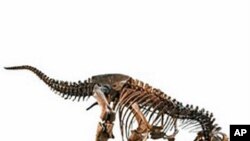A one-of-a-kind exhibit has been unveiled in Los Angeles that shows the stages of growth of a long-extinct giant - the Tyrannosaurus rex dinosaur. The exhibit at the Natural History Museum of Los Angeles County updates our understanding of the ancient creature.
Experts from this museum unearthed all three of the fossilized skeletons. One is a baby three meters long. It died at about the age of two, and Luis Chiappe, director of the museum's Dinosaur Institute, says it is the youngest T rex ever discovered.
“Then we have an adolescent and a sub-adult, and they're set in a way that they allow us to point out the differences in growth and to show the remarkable growth of these animals, as well as talk about behavior," said Chiappe.
He says scientists now know that dinosaurs grew quickly. The T rex baby was lean and light, weighing only about 30 kilograms when it died. The sub-adult or young adult weighed 3200 kilograms when it died at age 18. This specimen, nicknamed Thomas, is one of the most complete T rex skeletons ever discovered, and measures 10 meters long.
T Rex remains are concentrated in the Western United States, and these three are from the U.S. state of Montana.
The three reconstructed skeletons have been posed and mounted, but the display is not yet finished. It will later show the three animals looking down on the carcass of a duck-billed dinosaur, reflecting modern understanding of dinosaur behavior. Scientists say the T rex probably lived in groups and may have been making the transition from cold-blooded to warm-blooded creatures. The T rex may have cared for its young, and was probably covered with feathers for at least part of its growth cycle. Luis Chiappe says the feathers were used for insulation or in a colorful display to attract mates. He notes that dinosaurs are related to modern birds, and probably acted more like birds than reptiles.
“They were definitely active," he said. "It's hard to tell whether they were just as active as a duck or a chicken running around, but they were definitely not the kind of sluggish type of animal like a crocodile that sleeps all day or a turtle."
Phil Fraley helped create the museum exhibit, and says the tableau showing dinosaurs getting ready to feast on a carcass tells a story.
“What we're trying to do is to create a sense of drama that hopefully the visitor will then be drawn into this tableau or this story and that through their imagination, that they'll create the ending of the story that they want," said Fraley. "And if we're lucky, it may spark someone's imagination that they'll dig ever further.”
Museum director Jane Pisano says some questions are left unanswered. Were the three dinosaurs members of a family getting ready to share a feast, or competitors preparing for a good fight? She says either scenario is possible.
The newly rebuilt dinosaur hall will answer some questions and pose many others through its display of more than 300 specimens, in addition to the three T rex skeletons. Pisano says our understanding of dinosaurs has changed in recent decades because of ground-breaking work done at this and other museums.
“So it has a kind of Indiana Jones excitement about it, but it's real," said Pisano. "And I think that when our visitors come, people of all ages, to see this wonderful exhibition, they're going to capture that excitement and have that enthusiasm as well.”
Like the fictional Indiana Jones, lab manager Doug Goodreau makes expeditions every year to dinosaur-rich sites in Montana, Western Canada, or Argentina.
But he says real-world paleontology is a team effort, not the work of a solo adventurer. Expeditions involve dozens of scientists and volunteers, and he says the effort is demanding.
“Just getting there and getting all of the equipment, lugging that out there, and getting all the people together and swinging that pick-ax or hammer and chisel to get that out of the ground, it is very rewarding," said Goodreau.
Luis Chiappe says that dinosaurs have always captured our imagination, more than most other species of animals.
“... because on the one hand, they are an incredible chapter of the evolution of life," he said. "But I think people think of dinosaurs like ancient dragons, as creatures that are extremely rare, with their colossal size, their shapes, their headgear, and so on. And they're also very fearsome for most people.”
He notes that dinosaurs went extinct 65 million years ago, long before humans came on the scene. Scientists believe they were victims of planetary cooling caused by either an asteroid strike or volcanic eruptions.
The paleontologist says visitors to Los Angeles can learn more about the story when the Hall of Dinosaurs opens in July.
Exhibit Shows Rapid Growth, Social Nature of Dinosaurs







